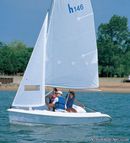Hunter 146
Sailboat specifications
The Hunter 146 is a 14’6” (4.42m) multiple crew dinghy designed by Chuck Burns Yachts (United States) and Hunter Design (United States). She was built since 2003 (and now discontinued) by Marlow Hunter (United States).
Hunter 146's main features
- Model
- Hunter 146
- Hull type
- Monohull
- Category
- Multiple crew dinghy
- Sailboat builder
- Sailboat designer
- Country
- United States
- Construction
- Thermoplastic:
Sandwich foam BASF Luran-S thermoplastic (outside skin) / glass fiber (inside skin) polyester - First built hull
- 2003
- Last built hull
- Discontinued
- Appendages
- Centerboard : pivoting centerboard
- Helm
- Single tiller
- Rudder
- Single transom hung rudder
- Unsinkable
- Yes
- Trailerable
- Yes
- EC design categoryiThe CE design category indicates the ability to cope with certain weather conditions (the sailboat is designed for these conditions)
A: Wind < force 9, Waves < 10m
B: Wind < force 8, Waves < 8m
C: Wind < force 6, Waves < 4m
D: Wind < force 4, Waves < 0,5m - D
- Standard public price ex. VAT (indicative only)
- N/A €
Hunter 146's main dimensions
- Hull length
- 14’ 6”4.42 m
- Beam (width)
- 6’ 6”1.98 m
- Draft
- 3’0.92 m
- Draft when appendages up
- 0’ 6”0.15 m
- Mast height from DWL
- 21’ 6”6.55 m
- Light displacement (MLC)
- 340 lb154 kg
Hunter 146's rig and sails
- Upwind sail area
- 128 ft²11.91 m²
- Rigging type
- Sloop Marconi 3/4
- Mast configuration
- Mast foot integrated on deck
- Rotating spars
- No
- Spreaders angle
- No spreader
- Spars construction
- Aluminum spars
- Standing rigging
- 1x19 strand wire continuous
Hunter 146's performances
- Crew
- Max. 4
- Upwind sail area to displacementiThe ratio sail area to displacement is obtained by dividing the sail area by the boat's displaced volume to the power two-thirds.
The ratio sail area to displacement can be used to compare the relative sail plan of different sailboats no matter what their size.
Upwind: under 18 the ratio indicates a cruise oriented sailboat with limited performances especially in light wind, while over 25 it indicates a fast sailboat. - 446 ft²/T41.45 m²/T
Hunter 146's auxiliary engine
- Engine(s)
- 1 outboard engine
- Engine(s) power
- 3 HP
Hunter 146's accommodations and layout
- Cockpit
- Closed aft cockpit



Marlow Hunter Hunter 146 layout - - 2/3
Picture extracted from the commercial documentation © Marlow Hunter
Picture extracted from the commercial documentation © Marlow Hunter


Marlow Hunter Hunter 146 sailing - - 3/3
Picture extracted from the commercial documentation © Marlow Hunter
Picture extracted from the commercial documentation © Marlow Hunter
Similar sailboats that may interest you:
Sailboats
First built hull
Hull length
2015
14’ 1”4.29 m
1995
11’ 6”3.5 m
1998
14’ 7”4.44 m
1997
12’ 10”3.89 m
1997
14’ 2”4.32 m
1983
14’ 2”4.32 m
1994
16’ 4”4.98 m
2008
15’ 1”4.6 m
2017
11’ 7”3.53 m
2008
14’ 6”4.42 m
2017
11’ 10”3.59 m
1949
14’ 10”4.5 m
2010
16’ 4”4.98 m
2018
19’ 8”5.99 m
1999
17’5.18 m